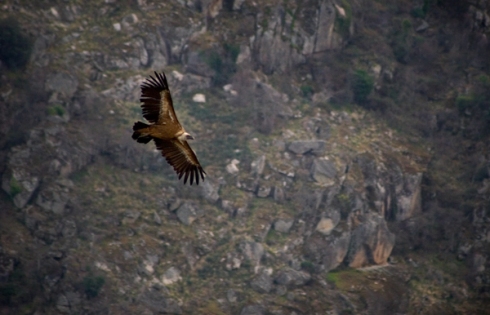Griffon, their name conjures images of legend and mythology, but in the skies above Spain and Portugal, thousands of real life griffon vultures survey the earth looking for their next meal. And to a griffon, nothing says “yummy” quite like a fresh pile of pork carcasses – well, maybe sheep.
Don’t knock it. They are one of nature’s best cleaner-uppers. But it turns out that griffon vultures and at least two other vulture species are ingesting something not on their carrion menu, drugs and lots of them.
Vulture numbers have soared in Europe since the 1980s, thanks in part to the common practice of carcass dumping of dead livestock, also called muladares, which provide vultures with a ready and reliable supply of chow. But in cattle, drugs abound. And lunch at a muladar promises a chemical cocktail of veterinary medicine as well as protein.

A griffon vulture soars in the skies above the Douro River in northeastern Portugal. (Photo/Morgan E. Heim)
A new study by Guillermo Blanco with Museo Nacional de Ciencias Naturales in Madrid showed that the proportion of vulture nestlings testing positive for antibiotics rose from 0 percent in 2001 to 70 percent in 2006, and now scientists are seeing a triple threat. Blanco found griffon, Egyptian and cinereous vultures, contained combinations of antibiotics, anti-parasitics and non-steroid anti-inflammatory drugs, such as aspirin, in their system, a never before seen combination in a wild animal, according to the researchers.
Scientists are still studying what this chemical cocktail could spell for the vulture, and the three species did show variance in the amounts and types of drugs found in their systems, possibly due to the differences in how they feed. But Blanco and his colleagues do mention possible reasons for why and how the drugs are building up in the birds’ bodies.
Vultures typically split mealtimes between muladares and “vulture restaurants,” scavenging from the carcasses of free-ranging livestock. Drugs abound in both food sources, but reside in much greater concentrations and types in the bodies of farm-raised cattle – farm-raised livestock require more drugs due to their compact living quarters. Recent European Union regulations aimed at curbing the spread of mad cow disease made it illegal to abandon carcasses of free-roaming cattle in the countryside. As an unintended consequence of the rule, this practice eliminated one key source of food for the vulture, concentrating food in the veterinary drug-laden muladares. The regulation has also been reputed to be a probable contributor to the vulture’s decline since 2003.
Side-effects could include increased disease, due to exposure to immuno-suppressants, changing delicate bacterial communities in the vulture’s system and a rise of infection or transmission at feeding sites.
One remedy would be to allow for carcass abandonment to resume according to the study. “There is no evidence of BSE [mad cow] transmission risk due to the abandonment of unstabled livestock carcasses in the countryside,” wrote the study authors. “Therefore, this traditional practice in the Mediterranean regions should be legally permitted in order to increase availability, dispersion and quality of food for scavengers.”
You can read more about Blanco and his colleagues’ findings in the December 2009 issue of the journal Animal Conservation.


